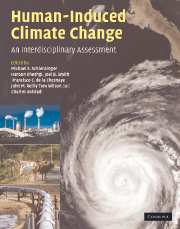Book contents
- Frontmatter
- Contents
- List of contributors
- Preface
- Part I Climate system science
- Part II Impacts and adaptation
- Part III Mitigation of greenhouse gases
- Part IV Policy design and decisionmaking under uncertainty
- 25 Climate policy design under uncertainty
- 26 Climate policy assessment using the Asia–Pacific Integrated Model
- 27 Price, quantity, and technology strategies for climate change policy
- 28 What is the economic value of information about climate thresholds?
- 29 Boiled frogs and path dependency in climate policy decisions
- 30 Article 2 and long-term climate stabilization: methods and models for decisionmaking under uncertainty
- 31 Whither integrated assessment? Reflections from the leading edge
- 32 Moving beyond concentrations: the challenge of limiting temperature change
- 33 International climate policy: approaches to policies and measures, and international coordination and cooperation
- Index
- Plate section
- References
33 - International climate policy: approaches to policies and measures, and international coordination and cooperation
from Part IV - Policy design and decisionmaking under uncertainty
Published online by Cambridge University Press: 06 December 2010
- Frontmatter
- Contents
- List of contributors
- Preface
- Part I Climate system science
- Part II Impacts and adaptation
- Part III Mitigation of greenhouse gases
- Part IV Policy design and decisionmaking under uncertainty
- 25 Climate policy design under uncertainty
- 26 Climate policy assessment using the Asia–Pacific Integrated Model
- 27 Price, quantity, and technology strategies for climate change policy
- 28 What is the economic value of information about climate thresholds?
- 29 Boiled frogs and path dependency in climate policy decisions
- 30 Article 2 and long-term climate stabilization: methods and models for decisionmaking under uncertainty
- 31 Whither integrated assessment? Reflections from the leading edge
- 32 Moving beyond concentrations: the challenge of limiting temperature change
- 33 International climate policy: approaches to policies and measures, and international coordination and cooperation
- Index
- Plate section
- References
Summary
Introduction
Since the industrial revolution, anthropogenic activities such as the burning of fossil fuels, and agricultural and industrial production, have led to growing emissions of greenhouse gases. It is projected that a sustained increase in the demand for energy, particularly in developing countries, and the continued reliance on fossil fuels as an energy source, will cause anthropogenic emissions to rise substantially into the future. The continued growth in emissions is expected to significantly increase atmospheric concentrations of green-house gases beyond current levels. Evidence now suggests that these human-induced increases in atmospheric greenhouse gas concentrations have the potential to alter the Earth's climate dramatically, leading to possible environmental and economic damage (Schneider and Sarukhan, 2001).
Human-induced climate change is a global phenomenon that is expected to have impacts in all regions of the world, although with differing specific effects. As a result, responding to the climate problem poses several challenges. One key challenge is to design policies that balance the cost of any damage from climate change with the cost of actions to reduce that damage. However, the considerable uncertainties surrounding the causes, nature, and impacts of possible climate change magnify this challenge. A second challenge will be for countries to manage adaptation, which could involve major investments and managing economic and social change. Of course, significant adaptation will occur as a result of economic agents responding to changes in both their physical and economic environments.
- Type
- Chapter
- Information
- Human-Induced Climate ChangeAn Interdisciplinary Assessment, pp. 403 - 413Publisher: Cambridge University PressPrint publication year: 2007
References
- 1
- Cited by



